Sandblasting Media Types Listed out for Buyer’s Reference
There are at least 20 different types of sandblaster media or abrasives commercially available. Many of them are used only for very esoteric applications such as dry ice which is used in mold cleaning. Dry ice is also unique in that there is no leftover media to clean-up since the dry ice evaporates. For clarity, the following popular sandblasting abrasives are grouped by their aggressiveness.
Soft Abrasives
Media like pumice, baking soda, plastic, Walnut shell grit and sponge are among the softest abrasives available. They are all high-cost abrasives use in delicate cleaning operations and renovation of antique or historical items. All are capable of removing surface treatment without damaging the material underneath. Sponge is unique in that it is available as fine as 320 mesh.
Medium Abrasives
The more aggressive abrasives include crushed glass, glass bead and ceramic bead. These abrasives are very popular among engine re-builders and body-shop mechanics. They are medium priced abrasives and with the exception of crushed glass, they can be reused. Garnet and Jetmag could be included in this group however unlike the others, they are capable of removing metal which can be a problem in certain auto rebuilding activities.
High Abrasives
These are the more widely used abrasives outside of the automotive industry. Silicone Carbide is a very sharp abrasive that fractures into small but equally sharp fragments. This feature allows Silicone Carbide to be reused many times. Aluminum Oxide is quite similar to Silicone Carbide and both are popular with glass workers. Aluminum Oxide has a unique characteristic of generating static electricity making it difficult for the vacuum system to evacuate the dust. Both abrasives are available in a wide variety of grits.
Other Abrasives
Other abrasives too unique to easily classify include: corn cob, coal slag and steel shot. These are examples of abrasives with niche applications such as metal when working outdoors. The abrasive which is most obvious by its absence is silica sand. Anyone tempted to use sand because it is cheap and works well would do well to read the Center for Disease Control's Alert titled "Preventing Silicosis and Deaths From Sandblasting."
Tags: Feng Blast News


